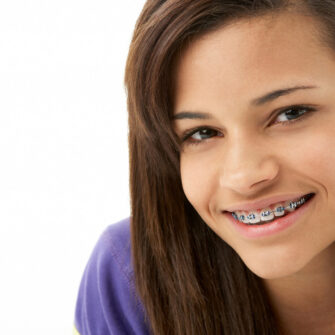When considering orthodontic care, aesthetic appearance is often the highest concern. However, beyond cosmetic considerations, teeth alignment and proper bite relations fundamentally contribute to dental health.
Proper alignment of jaws and teeth affects everything from your bite and chewing efficiency to your speech and long-term oral health. This article can help you better understand the process if you’re considering options to straighten your teeth.
Do You Have a Bad Bite?
One of the most common questions in orthodontics is whether teeth are supposed to touch each other. The simple answer is yes, but the reality is more nuanced. Think about two gears that fit together. The gears’ “teeth” are engineered to align in a specific way to perform a specific task. The gears can’t do their jobs if they don’t come together correctly.
It’s the same with your teeth. Upper and lower teeth should fit a certain way with their counterparts in the opposite jaw. If the fit is off, the bite is not right, even if the front teeth appear straight. If you don’t correct a misaligned bite, you set the stage for potential problems in the future.
Ideal Teeth Positioning
When your mouth is closed in a resting position, your upper and lower teeth should gently touch each other. Ideally, the upper teeth slightly overlap the lower teeth, ensuring a harmonious bite. This ideal positioning distributes the force of your bite evenly across all your teeth, reducing the risk of uneven wear and tear.
Variations in Teeth Alignment
Although it’s best for your teeth to touch slightly, variations are common. These variations can lead to bite problems that include:
- Underbite (anterior crossbite): The top teeth are positioned behind the bottom teeth.
- Open Bite: Can appear in two forms: the back teeth are closed, but the front teeth don’t meet, or the front teeth meet, but the back teeth don’t touch.
- Deep Bite: The top teeth completely cover the bottom teeth.
- Crossbite: The bottom teeth may be positioned outside the top teeth, or a crossbite can also occur if the bottom teeth are completely inside the top teeth.
Orthodontic Treatment for Misaligned Teeth
Orthodontic treatment aims to improve your bite, making eating easier and more comfortable. Additionally, well-functioning teeth often look better. By repositioning teeth within the jawbones, your orthodontist can ensure your teeth meet as intended to allow for proper biting and chewing.
An improper bite can lead to further jaw joint problems and increased risk of activities without proper treatment. Misaligned teeth can cause problems like premature wear and chipping, making it hard to eat and speak properly.
A healthy bite applies to all your teeth, not just the ones people see when you smile. To avoid potential problems, you can check your bite by consulting an AAO orthodontist near you.
Teeth Alignment Methods
After reviewing your bite, your orthodontist may recommend treatment to correct your teeth and jaw alignment. Reliable, proven alignment methods can improve your smile and address functional concerns related to eating, speaking, and oral health.
Traditional Braces
Braces are one of the most common and effective methods for correcting misaligned teeth. They consist of metal brackets attached to the teeth, connected by wires and sometimes rubber bands. Braces apply continuous pressure to the teeth, gradually moving them into the desired position. They are particularly effective for complex or severe alignment issues and are suitable for patients of all ages.
Clear Aligners
Clear aligner systems are custom-made, transparent plastic trays that fit snugly over your teeth. Adults and teens often prefer clear aligners because they are virtually invisible and can be removed when necessary.
Retainers
After treatment with braces or aligners is complete, retainers are typically used to maintain the teeth’s new position.
Surgery
If the misalignment is severe or caused by skeletal issues, you may need a combination of orthodontics and orthognathic surgery. These surgeries could involve jaw surgery to correct the alignment of the jawbones and typically include traditional orthodontic treatments for optimal results.
Visit an AAO Orthodontist to Fix Your Bite
The American Association of Orthodontists (AAO) is open exclusively to orthodontists. The only doctors who can call themselves “orthodontists” have graduated from dental school and completed the additional two to three years of education in an accredited orthodontic residency program.
When you partner with an AAO orthodontist, you can rest assured that your specialist will give you your best smile. Locate AAO orthodontists through our Find an Orthodontist page and schedule your alignment consultation today.



